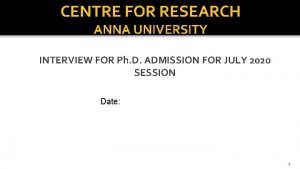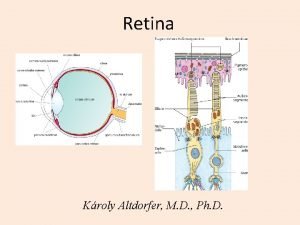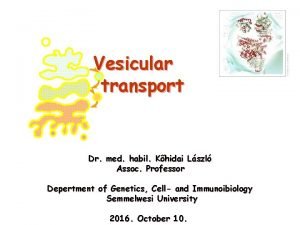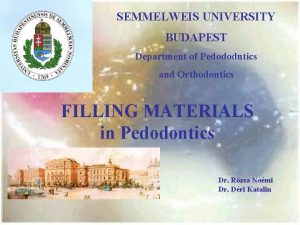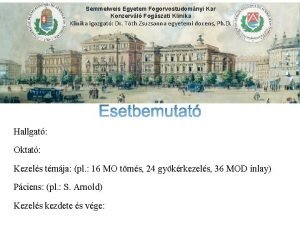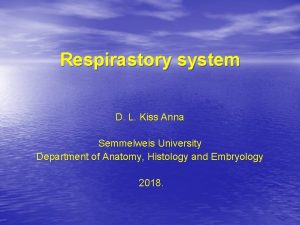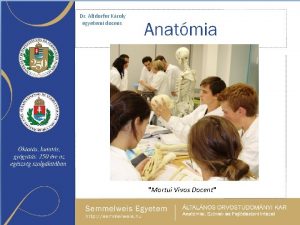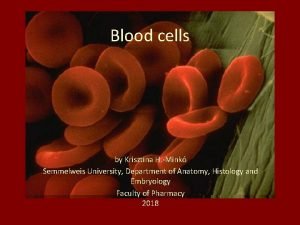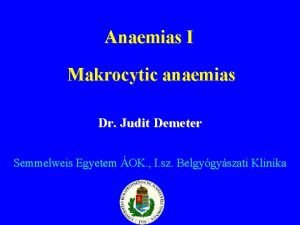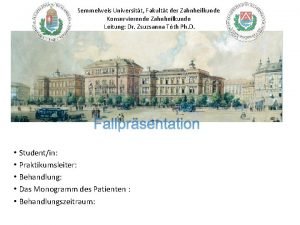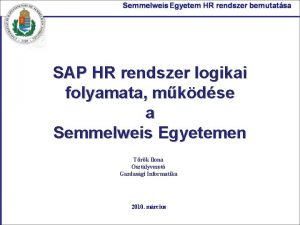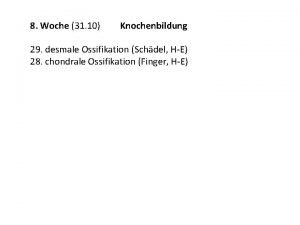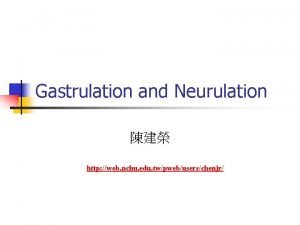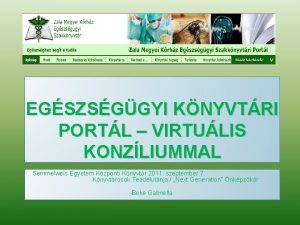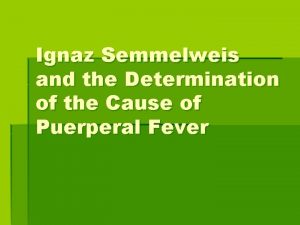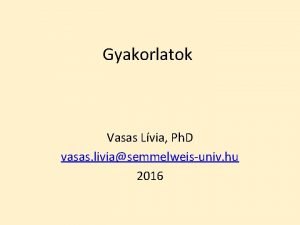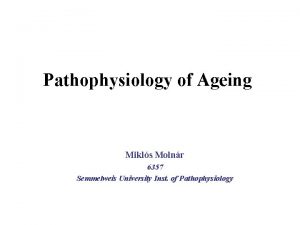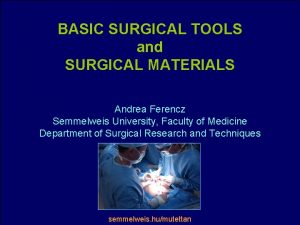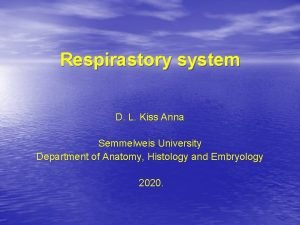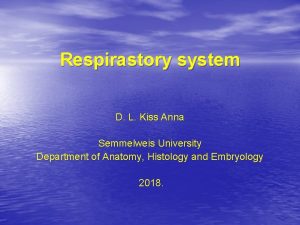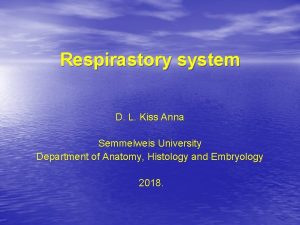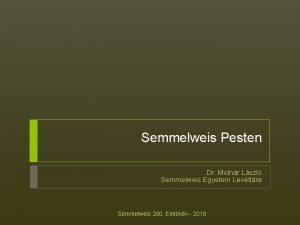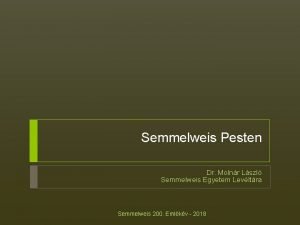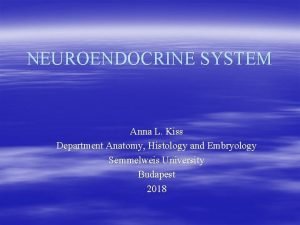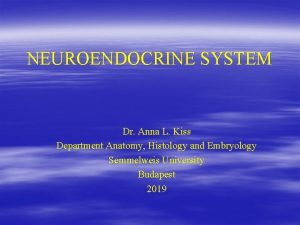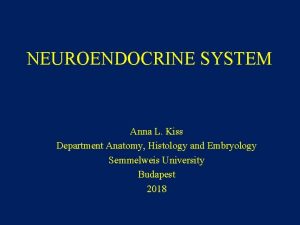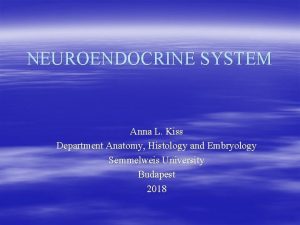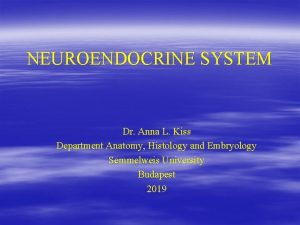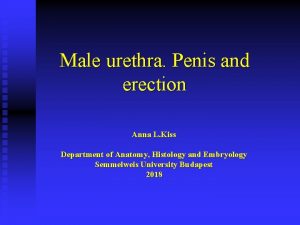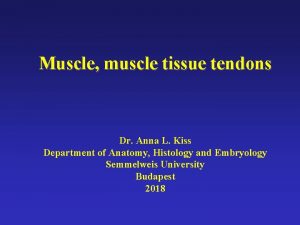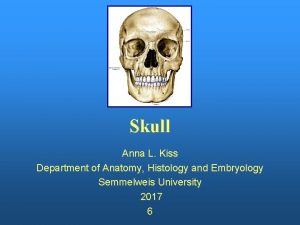Respirastory system D L Kiss Anna Semmelweis University



































- Slides: 35

Respirastory system D. L. Kiss Anna Semmelweis University Department of Anatomy, Histology and Embryology 2018.

• Extrapulmonar: – Nasal cavity - nasopharynx – Larynx – Trachea • Intrapulmonar: – Bronchi: principal lobar segmental – Bronchioles: terminals respiratory • Repiratory part: alveoli

Nasal cavity Olfactory area: receptors Regio respiratorica: pseudostratified ciliated epithelium (goblet cells) Vestibulum: skin

Regio respirtorica: vestibulum Propria: seros+mucus glands

Olfactory region cilia bulb-like ending supporting cell Receptors: primary sensory cells: bipolar cells • contain OBP (odorant binding protein) receptors on their plasma membrane receptor • axon-like processes - fila olfactoria – bulbus olfactorius • the number of them: 2 x 107 basal cells Schwann cells axon basement membrane • life time: 30 -60 days • more than 100 receptor molecules

nasopharynx tongue oropharynx soft palate laryngopharynx epiglottis

Nasopharynx

Waldeyer’s lymphatic ring Pharynx: pars nasalis: • tonsilla pharyngea+tonsillae tubariae (pseudostratified ciliated epithelium) p. oralis: • tonsilla palatina (stratified nonkeratinized epithelium) • tonsillae linguales (stratified nonkeratinized epithelium)

Larynx: epiglottis

Larynx epiglottis vestibular fold aryepiglottic fold vestibulum ventriculus vocal fold (vocal cord) infraglottic cavity

Histology of the larynx

Histology of the larynx

• lamina propria: fibers: fibroelastic membrane

Trachea anterior view Right posterior view left right Principal bronchi left

Trachea

Bronchus tree Principal bronchus lobal bronchus segmental bronchus bronchiolus terminal bronchiolus respiratoricus alveoli sacculus: ductus alveolaris

Histological changes in the respiratory system • cartilage disappears: gradually • glands are disappearing • smooth muscle becomes continuous (broncioles) and then disappears • epithelium becomes thin

Lung

Lung

Branches of the terminal bronchi, sacculi and alveoli Lobes : segments Segments: borders: veins artery + bronchioles (centrally)

Clara cells

Clara cells

Alveoli and alveolar septi macrophage alveolar entrance elastic fibers type I cells type II cells capillary macrophage in the septum

Alveoli: pneumocytes

Type I. and II. pneumocytes, alveolar makrophages

Pneumocytes: simple squamous epithelial cells Type I cells: flat, squamous cells: gass exchange Type II cells: surfactant secretion: decreases the surface tension

Surfactant Decreases the alveolar surface tension, actively participate in the clearance of foreign materials Low surface tension: increases the flexibility of the lung makes the alveoli stabil e Absence of the surfactant: alveoli collapse

Respiratory distress syndrome (RDS) – functional surfactant disorder • Fetal or neonatal RDS (IRDS): more frequent in premature infant 1. ) unmatured biosynthetic pathways 2. ) inactivation of the surfactant (intraalveolar coagulation) 3. ) increased use of surfactant caused by chronic respiratory mechanism 4. ) injury of the biosynthetic pathway (acidosis, decreased pulmonary blood flow) • Adult RDS (ARDS): acut respiratory insufficiency activation of neutrophyl granulocytes and alveolar macrophages release of permeability increasing substances (shock, trauma: . burning, infections, inhalation of toxic gases, overdosage of drogss etc)

Development of the lung 4 weeks embryo: respiratory diverticulum: outgrowth of the ventral wall of the foregut; • in the mesoderm retinoid acid production • • is increasing in the endoderm TBX 4 transcription factor production TBX 4: induces appearance, increase and differentiation of the lung primordia • epithelium: endoderm • connective tissue, cartilage and muscle: mesoderm

Development of the lung 1. ) respiratory diverticulum communicates with the foregut 2. ) Tracheoesophageal ridge: dorsal: esophagus ventral: trachea 3. ) 2 bronchus buds at the 5 th week: - right and left principal bronchi - then: right: 3 lobar brobnchi, left: 2 lobar bronchi - dichotomic division: segmental bronchi

Development of the lung

Development of the lung


The effect ot the fetal surfactant

Bibliography • Snell RS, Clinical Anatomy, Little, Brown & Co, • • • Boston, 1995 Moore KL, Dalley AF: Clinically Oriented Anatomy, Lippincott, 1999 Sobotta: Atlas of Human Anatomy Röhlich: Szövettan
 Ileocoecal
Ileocoecal Ductus intercalaris
Ductus intercalaris Semmelweis
Semmelweis Territorial matrix vs interterritorial matrix
Territorial matrix vs interterritorial matrix Semmelweis university faculty of medicine
Semmelweis university faculty of medicine Clarivites
Clarivites Doktori hivatal sote
Doktori hivatal sote Itc semmelweis
Itc semmelweis Retikulinfasern leber
Retikulinfasern leber Semmelweis
Semmelweis Orthodontics semmelweis
Orthodontics semmelweis Semmelweis
Semmelweis Semmelweis egyetem konzerváló fogászati klinika budapest
Semmelweis egyetem konzerváló fogászati klinika budapest Semmelweis egyetem szemészeti klinika budapest
Semmelweis egyetem szemészeti klinika budapest Semmelweis egyetem doktori iskola
Semmelweis egyetem doktori iskola Nasal vestibule
Nasal vestibule Semmelweis
Semmelweis Erasmus plus semmelweis
Erasmus plus semmelweis Altdorfer károly
Altdorfer károly Different between plasma and serum
Different between plasma and serum Semmelweis arc
Semmelweis arc Tsh szint
Tsh szint Konservierende zahnheilkunde semmelweis
Konservierende zahnheilkunde semmelweis Hr alrendszerek
Hr alrendszerek Perichondrale knochenmanschette
Perichondrale knochenmanschette Ignas semmelweis
Ignas semmelweis Neurulation
Neurulation Semmelweis portál
Semmelweis portál Pathophysiologie semmelweis
Pathophysiologie semmelweis Semmelweis reflex
Semmelweis reflex Tubulointerstitial nephritis
Tubulointerstitial nephritis Arthus reakció
Arthus reakció Zuzana 6357
Zuzana 6357 Semmelweis egyetem humán erőforrás
Semmelweis egyetem humán erőforrás Amnionüreg
Amnionüreg Weilaner
Weilaner





